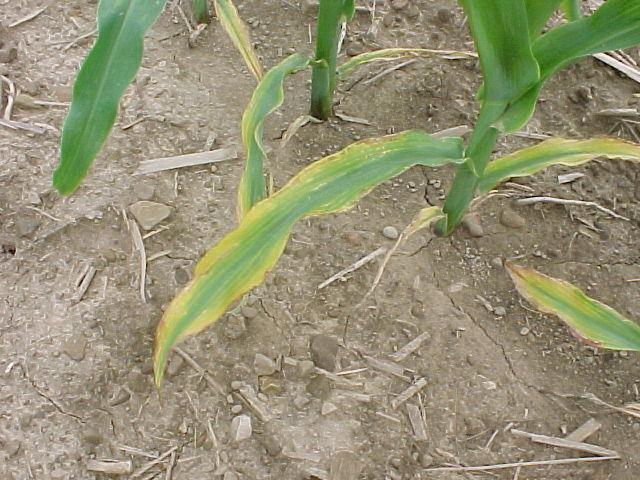Potassium (K) is a macronutrient for corn and the plant takes up large amounts throughout the growing season. While K is not used by the plant as a building block for organic compounds, it functions as an activator for many enzymes and metabolic pathways, including those for photosynthesis and protein and starch formation in grain. Potassium plays a role in the flow of water, nutrients, and carbohydrates within the plant. It plays a role in the regulation of stomata closing and opening, thus impacting the exchange of water and gases. Additionally, K is key for cell wall strength and cellulose production. Good K fertility is associated with strong cell walls that enhance disease resistance and the ability of the crop to maintain firm, healthy stalks (Table 1).
Table 1. Effect of K fertilization on stalk strength and rind thickness.1
| K2O rate, lb/A |
Rind thickness, mm |
Crushing strength, kg |
| 0 |
0.91 |
254 |
| 60 |
0.97 |
349 |
| 120 |
1.00 |
374 |
As corn production levels increase, balancing the nitrogen (N) level with the level of K is important for managing disease occurrence and stalk strength.
When K is limiting, the plant will be limited on the amount of N it can absorb from the soil, thus impacting stalk strength, disease tolerance, and grain yield.
Potassium is considered an immobile nutrient in the soil but is very mobile within the plant. Potassium that occurs naturally in the soil is, for the most part, unavailable to the plant as it is primarily found in minerals, such as mica, and only becomes available when the mineral degrades. Corn residue contains a substantial amount of the K taken up by the plant during the growing season, over 60%. A 200 bu/acre (12.5 t/ha) corn yield will take up 266 lb/ac (300 kg/ha) of K2O from the soil; however, only 0.25 lb/bu (4.5 kg/t of grain) of K2O will be removed with the grain component.2 For the above example, 50 lb/acre (56 kg/ha) of K2O will be removed from the soil. If the field is harvested for silage, the removal rate increases dramatically to 9.2 lb/ton (4.6 kg/t of silage) which works out to over 180 lb/acre (200 kg/ha) of K2O with a 20 ton/acre (45 kg/ha) silage yield.3
Potassium Sources in Fertilizers
Because approximately 98% of the K in the soil is not available to the plant, forms of K fertilizers are needed to maintain yield goals. In continuous corn production, an optimum level of K in parts per million (ppm) in a loam soil is 100 – 130 and for a sandy soil it is 65 – 90. In a cropping system where corn silage is produced, the demand level would be higher, so in a loam soil the optimum level would be 110 to 140, and 80 to 120 for sand-based soil types.4 Some common forms of K fertilizer are potassium chloride, potassium sulfate, potassium nitrate, and several forms of potassium phosphates.
Factor Impacting Potassium Uptake5
Factors that impact K uptake include:
- Soil moisture; with increasing soil moisture, K availability and movement in the soil increases, as well as plant uptake. Response to K applications is usually higher in dry years.
- Soil compaction can decrease the oxygen availability to roots, which will reduce K uptake. While an increase in soil moisture will increase uptake of K, a saturated soil will result in decreased uptake as oxygen is depleted. Additionally, compacted soils can have restricted root growth, thus reducing K uptake. Sidewall compaction can directly impact K uptake by limiting root growth.
- Root stress can limit K uptake to the point of the plant showing deficiency symptoms, even when soil K is adequate. Root stress caused by dry soils, pruned roots, low soil temperature, and compacted soils can contribute to K deficiency in the presence of adequate K levels. The symptoms of K deficiency usually do not become visible until the V6 growth stage, about 6 weeks after planting, as this coincides with accelerated K uptake.6 If the plant is under root stress, the symptoms become more obvious at this time (Figure 1).
- The tillage system can impact soil K availability, but the impact has not been shown to be consistent. Though reduced tillage systems, such as no-till and ridge till, can have lower soil K availability than conventional-tilled systems, it may be related to cooler soils in the spring or stratification of K in the soil profile.
 Figure 3. Symptom of K deficiency in corn.
Figure 3. Symptom of K deficiency in corn.
Sources
1Effects of Potassium on Plant Diseases. 1998. Better Crops with Plant Food. International Plant Nutrition Institute. Volume 82(3): 37-39.
2Silva, G. 2017. Nutrient removal rates by grain crops. Michigan State University Extension. https://www.canr.msu.edu/news/nutrient_removal_rates_by_grain_crops.
3Heinrichs, J. and Roth, G. 2001. Corn Silage Production and Management. Pennsylvania State University Extension. https://extension.psu.edu/corn-silage-production-and-management.
4Laborski, C. and Peters, J. 2012. Nutrient Application Guidelines for Field, Vegetable, and Fruit Crops in Wisconsin. University of Wisconsin Extension Guide A2809.
5Sawyer, J. 2000. Potassium Deficiency Symptoms in Corn. Iowa State University Extension. https://crops.extension.iastate.edu/potassium-deficiency-symptoms-corn.
6Welch, L. and Flannery, R. 1985. Potassium Nutrition of Corn. In Potassium in Agriculture. Agronomy Society of America-Crop Science Society of America-Soil Science Society of America. Pages 647-664. doi:10.2134.
Web sources verified February 17, 2022.
Legal Statements
Performance may vary from location to location and from year to year, as local growing, soil and weather conditions may vary. Growers should evaluate data from multiple locations and years whenever possible and should consider the impacts of these conditions on the grower’s fields.
Bayer and Bayer Cross are registered trademarks of Bayer Group. Used under license. ©2022 Bayer Group. All rights reserved. 1011_S2